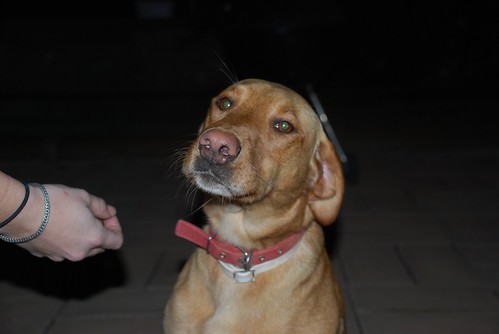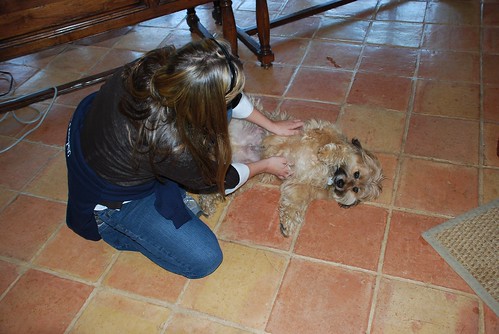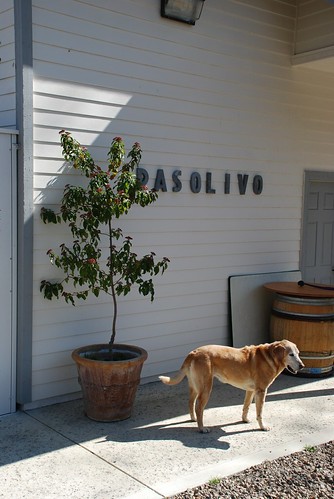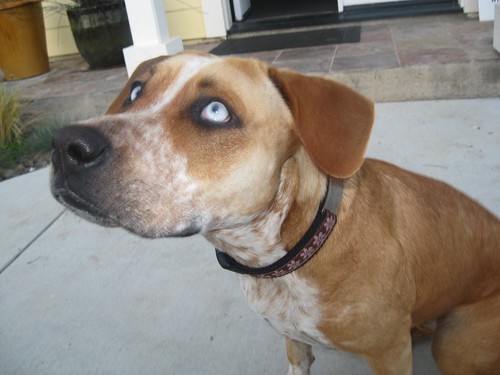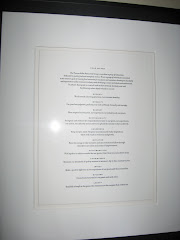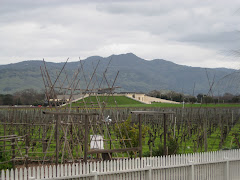If you paid attention to these posts, you may have noticed that I had a little too much wine that last night in Santa Barbara. Unfortunately for everyone, Tuesday was my day to drive. And I had to drive to LA...good times.
As other posts will show, we did a little surfing the last morning in SB, which we planned poorly regarding getting packed etc...and out of the hotel by noon. We are slightly salty, and starving. We pull over in a little town for a slice of pizza (under normal circumstances this would have kicked my headache right out the door), but when I stepped on the broken Modelo beer bottle in the parking lot it put me back in a foul mood. Even more frustrating might have been the young man at the pizza counter who didn't have a First Aid kit (which is illegal BTW!). Pizza was sub-par, and my mood worsened until Kel and Kim took me to "Coffee bean and Tea Leaf" for a pick me up.
Now: the drive to LA: What madness! Luckily we are 3 people and qualify for HOV lane activity (although this wasn't exactly a drastic improvement from the other 19 lanes!). We rarely had timing problems with the GPS, but on this particular trip, we added 48 minutes to the drive.
But we arrived, safe and sound in Palso Verdes. We had our "last supper" together, as Kelly and Kim took off for the East Coast early the next mornign and I hung out in LA to spy on more wine lists, cocktail menus and wine merchants until the 14th.
Tuesday, February 12, 2008
Banging surfboards...

When we wake early Tuesday morning, we decide to do a dawn patrol with our rental boards at the beach. What starts as a "quick walk" turns into us chasing breaks down the beach, until we were (in Melissa's opinion) dangerously close to the locals.

Kelly did amazing, she surfed for nearly 3 hours. Kim and I took a turn or 2 each, before check-out time crept up on us and I dashed for the car to haul our belongings back in.
the car to haul our belongings back in.

Kelly did amazing, she surfed for nearly 3 hours. Kim and I took a turn or 2 each, before check-out time crept up on us and I dashed for
 the car to haul our belongings back in.
the car to haul our belongings back in.Monday, February 11, 2008
Foley Wines
Established in 2001, the Santa Rita Hills AVA is a unique, ultra-cool climate growing area located in the westernmost section of the Santa Ynez Valley. Situated at the foot of Point Conception with the Purisima Mountains to the north and the Santa Rosa Mountains to the south, the mountains form the most significant western running corridor into the Pacific Ocean from Alaska to Chile. The AVA benefits from brisk daily ocean breezes and early forming, late dissipating maritime fog which blankets the vineyards and makes the Santa Rita Hills one of the coolest growing regions in the world. The soil types are varied, with marine sand, loam, clay and limestone widely found. Elevations range from virtual sea level to eighteen hundred feet. The area is semi-arid, with average rainfall of thirteen inches annually. Almost all rainfall comes between the months of December and May. This permits vintners the opportunity to allow fruit extended "hang time", without the menace of fall rains that afflict other Pinot Noir and Chardonnay growing regions. The extreme nature of the Santa Rita Hills, in particular, the cold, windy climate lead to the low yields that create Pinot Noirs of great density of color, and overall intense flavor characteristics in all wines.
LinCourt Vineyards
LinCourt is fortunate to be situated in one of the great grape growing areas in the world, Santa Barbara County. The diversity of the County is reflected in each wine. Unique to the west coast of North America, Santa Barbara is blessed by two valleys with east-west orientation. The Santa Maria and Santa Ynez Valleys funnel the cool ocean breezes and maritime fog to the western vineyards, creating a haven for the cool climate varietals, Pinot Noir and Chardonnay. In the warmer reaches, farther from the ocean, grapes such as Syrah and classic Bordeaux varieties thrive as the fog cools the vineyards at night, allowing the grapes to retain proper acid and sugar balance.
Santa Barbara County also enjoys one of the longest grape growing seasons in the world. Mild winters result in early bud break. Unlike many other notable growing areas, fall in Santa Barbara is typically rain free, allowing the grapes extended time to hang on the vine. The results are grapes that are physiologically mature and extremely flavorful without overripe character.
Santa Barbara County also enjoys one of the longest grape growing seasons in the world. Mild winters result in early bud break. Unlike many other notable growing areas, fall in Santa Barbara is typically rain free, allowing the grapes extended time to hang on the vine. The results are grapes that are physiologically mature and extremely flavorful without overripe character.
Santa Barbara...how I adore thee

We wake up at Bill's in Paso and load the car and head to Paso Robles. Naturally, we hit the first In N Out burger along the way for sustanance.
We hit Foley vineyards for a noon tasting and LinCourt shortly after. We make our way into Santa Barbara proper and find our hotel right on the main "drag" if you will.
We hit Foley vineyards for a noon tasting and LinCourt shortly after. We make our way into Santa Barbara proper and find our hotel right on the main "drag" if you will.
We check into our hotel for the night, The Harbor View Inn, and find an amazing hotel room waiting for us. We are tired, we have packed up our clothes and moved about 12 times in 2 weeks, and we are quite thirsty. The beach is right there, and so is a pool. While Kel and Kim wander the streets of SB looking for surfboards, I grab a chilled bottle of Jordan Chardonnay and hope to the pool (there will be no pictures of this, as nothing spells "not sexy" like my body in February). Clear across town, Kim hears the cork pop and darts back to help me polish off this bottle (and another). We put on some clothes and head to a Mexican restaurant for some take out, only to discover that the location we called for pick up is actually 25 miles away...oopss. They drive it down, and we head back to the lovely room for dinner (Melissa's note: After dinner, I wandered back down to the hot tub, only to find a woman who "is really a nurse but paid to hang out at the hotel" naked in the hot tub. I think this makes her a hooker? Kelly and Kim: we are not in Sonoma anymore!).
Sunday, February 10, 2008
Olive Oil pressing...
As a side bar, we visited an Olive oil press in Paso Robles. It's called Pasolivo, and while they were not actively "pressing" due to the time of year, it was very cool and would be if you visited during the appropriate time frame.
L'Aventure
Paso Robles: East vs. WestWe immediately favored the west side of Paso Robles for its sloping hills and authentic quality terroir. Another factor for this decision was the proximity of the Templeton Gap, a breach in the Coastal Range through which cool breezes blow continuously. The area is characterized by early fog in the morning, warm clear days, and nighttime temperatures that can drop by approximately 40 degrees.
The Vineyard The site, which was not planted, was selected after an extensive study of the area that matched with our long experience in the wine industry. The property covers a total of 127 acres and has many hills of various elevations, complex soils, and excellent drainage.The Terroir The importance of the terroir is fundamental to obtaining a high quality wine. The vineyard is planted on the western side of the Paso Robles hills, providing maximum daylight exposure.
Under the thin layer of top soil, which is barely 10 inches thick at the top of the hills and 24 inches at the bottom, there are several layers of limestone, rock-shell, traces of clay, metal, and quartz. This mosaic of soil brings complexity to the fruit. The rock shell / clay combination acts like a sponge, storing water during the rainy season, and redistributing it back to the roots in the dry season. This insures a constant feeding for the vines, giving them a more balanced water source, as opposed to simple irrigation. This also helps to keep the soil moist longer, allowing for a later harvest.
Adopting the notion of terroir means to reject the more fertile soil in favor of leaner ground. This preserves the authenticity of the wine, providing a good balance between alcohol and acidity, thereby enhancing finesse and elegance.
The Cal Poly Earth & Soil Sciences Soil Survey Team recently did an in depth soil analysis at L'Aventure. To look at a breakdown of their findings click here.
The Planting The choice of rootstock was made to take full advantage of the terroir. Only those with a long, slow maturation, and a deep root system were selected.
For the same reason, planting was done with a very high density of more than 2000 plants per acre.
The irrigation system was designed specifically with the ability to irrigate each row separately. This allows an optimum balance between the amount of water, the sun exposure, and the soil.
The choice of location for each varietal, the irrigation option, the terroir, and the high density emphasizes more complexity and concentration in the fruit. Because of the Paso Robles location, we are convinced that blending is absolutely essential in order to obtain the right balance between tannins, alcohol and acidity, without any one varietal overpowering the others. This insures a superb wine with great originality.
As of 1999, the varietals planted are: Syrah 37%, Cabernet Sauvignon 50%, Petit Verdot 13%. There are also small parcels of Grenache and Chardonnay. With the next tranche of plantation in 2000 and beyond, the percentages will be modified slightly: Syrah 36%, Cabernet Sauvignon 36%, Petit Verdot 9%, Mourvèdre 9%, plus some 3 acres of Roussanne and Viognier.
The Viticulture The foliage is a very important element. It is the "maturity factory" of the vine. This explains why the volume of foliage is so large: more than 4 feet, allowing a huge amount of leaf-growth.
The trellis system is vertical. The foliage is brought back up between the wires allowing significant sun exposure and greater maturity of the polyphenol (Tanin / Antocyan). This provides a better balance of the sugar/phenolic acid combination at harvest.
The pruning is the classic "Guillot Double" with a very low double cordon or low classic double cordon. The rows are disked and chiseled regularly to help the water penetrate and reach the deeper soil. This forces the root system to dig deeper and take advantage of the terroir.
The irrigation is not used systematically, but only when needed, mostly during flowering and véraison.
The time of harvest is based not only on the usual sugar level criteria, but also when the phenolic maturation is acceptable.
The yield harvested is limited to 2 tons maximum per acre to ensure premium fruit with an optimum concentration, tanin maturity and balance.
The Vineyard The site, which was not planted, was selected after an extensive study of the area that matched with our long experience in the wine industry. The property covers a total of 127 acres and has many hills of various elevations, complex soils, and excellent drainage.The Terroir The importance of the terroir is fundamental to obtaining a high quality wine. The vineyard is planted on the western side of the Paso Robles hills, providing maximum daylight exposure.
Under the thin layer of top soil, which is barely 10 inches thick at the top of the hills and 24 inches at the bottom, there are several layers of limestone, rock-shell, traces of clay, metal, and quartz. This mosaic of soil brings complexity to the fruit. The rock shell / clay combination acts like a sponge, storing water during the rainy season, and redistributing it back to the roots in the dry season. This insures a constant feeding for the vines, giving them a more balanced water source, as opposed to simple irrigation. This also helps to keep the soil moist longer, allowing for a later harvest.
Adopting the notion of terroir means to reject the more fertile soil in favor of leaner ground. This preserves the authenticity of the wine, providing a good balance between alcohol and acidity, thereby enhancing finesse and elegance.
The Cal Poly Earth & Soil Sciences Soil Survey Team recently did an in depth soil analysis at L'Aventure. To look at a breakdown of their findings click here.
The Planting The choice of rootstock was made to take full advantage of the terroir. Only those with a long, slow maturation, and a deep root system were selected.
For the same reason, planting was done with a very high density of more than 2000 plants per acre.
The irrigation system was designed specifically with the ability to irrigate each row separately. This allows an optimum balance between the amount of water, the sun exposure, and the soil.
The choice of location for each varietal, the irrigation option, the terroir, and the high density emphasizes more complexity and concentration in the fruit. Because of the Paso Robles location, we are convinced that blending is absolutely essential in order to obtain the right balance between tannins, alcohol and acidity, without any one varietal overpowering the others. This insures a superb wine with great originality.
As of 1999, the varietals planted are: Syrah 37%, Cabernet Sauvignon 50%, Petit Verdot 13%. There are also small parcels of Grenache and Chardonnay. With the next tranche of plantation in 2000 and beyond, the percentages will be modified slightly: Syrah 36%, Cabernet Sauvignon 36%, Petit Verdot 9%, Mourvèdre 9%, plus some 3 acres of Roussanne and Viognier.
The Viticulture The foliage is a very important element. It is the "maturity factory" of the vine. This explains why the volume of foliage is so large: more than 4 feet, allowing a huge amount of leaf-growth.
The trellis system is vertical. The foliage is brought back up between the wires allowing significant sun exposure and greater maturity of the polyphenol (Tanin / Antocyan). This provides a better balance of the sugar/phenolic acid combination at harvest.
The pruning is the classic "Guillot Double" with a very low double cordon or low classic double cordon. The rows are disked and chiseled regularly to help the water penetrate and reach the deeper soil. This forces the root system to dig deeper and take advantage of the terroir.
The irrigation is not used systematically, but only when needed, mostly during flowering and véraison.
The time of harvest is based not only on the usual sugar level criteria, but also when the phenolic maturation is acceptable.
The yield harvested is limited to 2 tons maximum per acre to ensure premium fruit with an optimum concentration, tanin maturity and balance.
Paso Robles part two
Off in the trusty Avenger for our 10 am tasting: Treana. (Please remember: all addresses have been preprogrammed carefully). We blindly follow Tim's guidance into, what appeared to be some sort of local industrial park, complete with defunct space ships and other NASA paraphanalia and the Paso Robles Juvenile Detention Center. But no Treana. We do see a warehouse that holds some production facility-like equipment, but no sign, locks everywhere etc... Tim is also showing us to be trespassing on Federal Land, so we consulate our map, reroute to a different listing for Treama and take off, only to end up at the Kermit King Elementary School. So, no Treana.
We reroute and head to Turley, where we taste thru their single vineyards and even persuade the tasting room attendant to open a bottle of the White Coat, a mutual fav Rhone Style Blend.
After Turley, we head to Pasolivio for some olive oil samplings. They were not pressing currently, as it seems to all be done prior to December. But they did have some funky flavors and blends that were yummy!
Off to Sam's, where we meet friend Dennis and pile into the Sam's Toyota and are chauffered around Paso to tasting rooms and farmers land.
Terry Hougue Vineyards is literally down the street from Sam. Terry is a University of Georgia football alumni from the early 80's and the last National Championship (Melissa noticed a UGA book on a shelf penned by Vince Dooley and Mark Ritch and immediatley cracked the case.) It is small and quality production, and in no way related to Hogue Vineyards. (Melissa's fav: The Hedge Syrah...Go Dawgs!)
We also hit: L'aventure, Lone Madrone and Windward.
One of our highlights of this trip is a visit to a farmer (I suppose viticulturist may be more accurate) named Don. Don meets us at the bottom of a hill with 2 John Deere Gators, we pile in, and he escorts us around his vineyard to learn pruning techniques, which is a first for the 3 of us. Don's presence in our trip made us decide to focus more on the farming next year, and hopefully working with some farmers and viticulturists here and there.
After we taste around the town, and wave good bye to Dennis, Sam invites us in for "some wine while your Thai takeout is cooking". She rolls out to the patio with Kim's fav: The Peasant. We sip our wine, discuss farming techniques for the up and coming "Chloe's Vineyard" and enjoy our lives. Afterwards, we wave goodbye to Sam and Chloe, with promises to see her in Nantucket and us back in Paso soon!
Overdose on Thai food and watch Will Farrell play the charming role of Ricky Bobby before falling asleep on the chair.
We reroute and head to Turley, where we taste thru their single vineyards and even persuade the tasting room attendant to open a bottle of the White Coat, a mutual fav Rhone Style Blend.
After Turley, we head to Pasolivio for some olive oil samplings. They were not pressing currently, as it seems to all be done prior to December. But they did have some funky flavors and blends that were yummy!
Off to Sam's, where we meet friend Dennis and pile into the Sam's Toyota and are chauffered around Paso to tasting rooms and farmers land.
Terry Hougue Vineyards is literally down the street from Sam. Terry is a University of Georgia football alumni from the early 80's and the last National Championship (Melissa noticed a UGA book on a shelf penned by Vince Dooley and Mark Ritch and immediatley cracked the case.) It is small and quality production, and in no way related to Hogue Vineyards. (Melissa's fav: The Hedge Syrah...Go Dawgs!)
We also hit: L'aventure, Lone Madrone and Windward.
One of our highlights of this trip is a visit to a farmer (I suppose viticulturist may be more accurate) named Don. Don meets us at the bottom of a hill with 2 John Deere Gators, we pile in, and he escorts us around his vineyard to learn pruning techniques, which is a first for the 3 of us. Don's presence in our trip made us decide to focus more on the farming next year, and hopefully working with some farmers and viticulturists here and there.
After we taste around the town, and wave good bye to Dennis, Sam invites us in for "some wine while your Thai takeout is cooking". She rolls out to the patio with Kim's fav: The Peasant. We sip our wine, discuss farming techniques for the up and coming "Chloe's Vineyard" and enjoy our lives. Afterwards, we wave goodbye to Sam and Chloe, with promises to see her in Nantucket and us back in Paso soon!
Overdose on Thai food and watch Will Farrell play the charming role of Ricky Bobby before falling asleep on the chair.
Subscribe to:
Posts (Atom)
